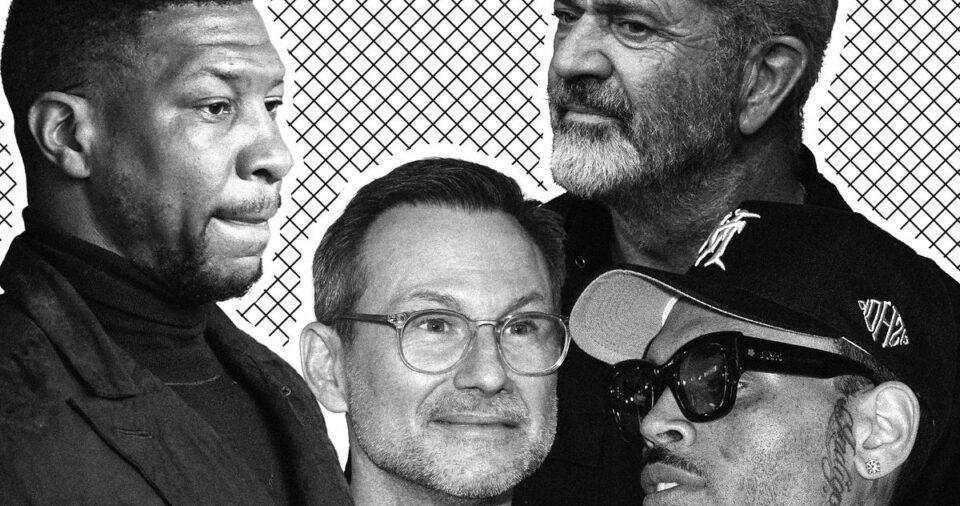[ad_1]

One evening last summer, I logged onto Zoom to observe a virtual counseling program for men who perpetrated domestic violence, run by a Boston-based group called Emerge. There were nine men of various ages and ethnicities and backgrounds on the call. Some were at home, video-conferencing from their bedrooms, one was in the car, and another was taking a leisurely walk outdoors, his sunglasses blocking his eyes from view. Emerge has a set format for these classes, which run weekly for 40 weeks and are generally populated by men court-mandated to attend by a judge. Participants begin by identifying themselves and the name of the person they abused, serving, it seemed to me, a dual purpose—centering the victim at the onset of the session and promoting responsibility. At Alcoholics Anonymous, it’s Hi, I’m John and I’m an alcoholic. At Emerge, it’s Hi, I’m John and I’m an abuser.
The walker, whom I’ll call Jeremy, was doing his weekly check-in with the group when David Adams, the co-founder of Emerge and one of two facilitators on the call, asked him a direct question: What was the abuse he committed that landed him in the program? Emerge encourages men to talk candidly and in detail about their abuse — what preceded it, what they did, how it impacted their partner — and accept feedback from the rest of the group about their behavior. The hope is that participants will begin to recognize and interrogate their own patterns of abuse and, over time, undergo the slow and uncomfortable process of change. To be successful, this intervention model requires active, incisive coaching by group leaders, Adams explained in a paper describing the program, as left on their own, “abusive men tend to give superficial or highly skewed reports of their interactions with their partners.”
Jeremy, still walking, began describing his relationship with his ex-girlfriend. They both struggled with insecurity, he said, leading to arguments over stupid things. “We were both wounded birds, just trying to soar through the sky, and we just, kind of like, we didn’t have very good communicative skills,” he said. Adams stopped his digressive answer there. The question, he reminded Jeremy, was how exactly did he abuse his partner? Now, Jeremy’s voice sped up. “Just like … pushing … I like, pulled her down the stairs, but like two … two stairs, you know?” he replied. “It wasn’t like I dragged her down a flight of stairs and she was all beat up or nothing crazy like that.” He went on: “I don’t want to reflect on my past because I am accountable for my actions, and stuff like that. But it was again, like I said, based upon our insecurities and not having good communicative skills.”
In Jeremy’s telling, his physical violence toward his girlfriend was caused by their mutual insecurity. It was only a few stairs. Nothing crazy. It is exactly this type of thinking that batterer intervention programs, as they are called, are designed to combat. Emerge, circa 1977, was the first such program in the U.S., born at a time when feminist activists were demanding national attention to the neglected issue of domestic violence. As hotlines and shelters sprung up for victims, Adams said, the natural next question within the movement was what to do with the men causing harm?
In the years since, programs have proliferated (over 2,500 exist, according to one count) and are now fully integrated into the criminal-justice system. These days, if you are convicted of a domestic-violence offense, it is likely you’ll be mandated to go to one. Millions of men have attended, including celebrities such as Mel Gibson, Christian Slater, and Chris Brown, who bragged about completing the class on Twitter: “Boyz run from there [sic] mistakes.. Men learn from them!!!” he wrote. (Four years later, a judge granted another woman, Karrueche Tran, a five-year restraining order against Brown, who she said he threatened to kill her.) And earlier this month, Jonathan Majors was sentenced to a 52-week batterer intervention program in California after being convicted of assaulting and harassing his ex-girlfriend Grace Jabbari.
In theory, group counseling to address the root causes of abusive behavior sounds promising. If batterer intervention programs make abusers less violent and, as a result, victims safer, why wouldn’t it be a preferable alternative to sentencing someone to, say, a year in jail, as Majors faced? But decades after the first programs were established, we have limited and highly contradictory research on how well they work. Some studies have found batterer intervention programs reduce future violence; others conclude they have little to no impact. The National Institute of Justice says results are “mixed.” Complicating matters, batterer intervention programs aren’t a monolith, and curriculum and quality varies wildly from one to another.
Most states have legal standards that regulate programs, but oversight falls to different departments with distinct goals. In California, for example, the Probation Department is in charge. In Massachusetts, it’s the Department of Public Health. Generally, participants are mandated to attend once a week for anywhere from 8 to 52 weeks (the longer the better for real change, Adams says). While models range, most programs are a mix of therapy and education, covering topics such as conflict-resolution skills, effects of abuse on partners and children, and how to take accountability. With victims’ consent, Emerge checks in with them throughout the 40 weeks to see if there has been any additional violence or threats and assess victims’ sense of safety. If a perpetrator refuses to own up to his actions or suggests he might commit more violence or stops attending, programs are typically supposed to communicate with probation, courts, and even the partner in question. “If we get somebody 12 weeks into our program who’s still blaming his partner, then we put that in a letter,” Adams said, which can be helpful to partners who are trying to make a decision about whether to stay in the relationship.
Adams, a psychologist who grew up with an abusive father, is a true believer in the power of these programs to save lives. When I asked him about the dismal research on effectiveness, he said studies often lump together participants who quit with those who complete it. Truly changing someone’s deep-seated and long-held thought patterns and beliefs takes time, he explained. “Many of the studies look at somebody who dropped out after one session and reoffend and count that as a program failure,” he said. “If substance-abuse programs were evaluated that way, they would all be considered to be failures.” He directed me to a 2015 pilot study conducted by the Harvard Kennedy School that assessed three batterer intervention programs in Massachusetts, including Emerge. It found that participants who completed such a program were 28 percent less likely to recidivate — measured as an arrest for a future domestic-violence-related crime — than those who failed to complete the program. Stated another way, those who dropped out were three times more likely to be arrested for domestic violence again than those who completed the work. (Of course, evaluating a program’s success using future arrests reveals only the tip of the iceberg, as domestic violence is chronically underreported to police.)
But while batterer intervention programs may prove effective when abusers attend, a huge portion of participants simply don’t. Anywhere from 15 to 58 percent of participants fail to complete treatment, often with few consequences. A 2022 state audit of California batterer intervention programs, including those in L.A. County, where Majors is expected to attend, found that probation officers and program providers frequently failed to inform the court about absences and other probation violations, including serious ones, such as contacting a victim under a protective order. In California, like in Massachusetts, those who completed the programs had a lower rate of reoffending than those who dropped out — 20 percent compared to 65 percent — but notably, nearly half of the domestic-violence offenders reviewed by the state did not complete the program. The “system has not adequately held offenders accountable,” the audit concluded, adding that these issues “have plagued the batterer intervention system for at least three decades, creating a critical need for statewide guidance and oversight.” Without proper supervision, these programs can end up functioning as literal get-out-of-jail-free cards.
In 2016, I was invited to attend a conference on batterer intervention in Dearborn, Michigan. For three days, I listened as leaders in the field, many of whom had been working on this issue since the ’80s, described what they’d learned. Session titles, such as “Real Change, Real Challenges: Moving Forward Through the Backlash” and “Let’s Set the Record Straight!” reflected a sense of frustration with how outsiders perceive the work. I left with the impression that many batterer intervention practitioners genuinely believe that reforming abusers is a critical step — maybe even the critical step — to reducing domestic violence yet is chronically underfunded, the ugly duckling of the movement to stop violence against women. Few advocacy groups are interested in raising money for programs that help abusers, especially if it seems like it might divert resources from victims.
Bringing us back to Jeremy, the Emerge participant. After he finally acknowledged to the group that he pushed his girlfriend down “two” stairs, Adams called him out. He noted that Jeremy kept referring to the core problem as “our” insecurities, as if his girlfriend’s insecurity played a role in the violence. “You’re taking responsibility for your abusive behavior means it’s 100 percent a choice that you’re making. Regardless of how insecure or whatever the other person’s feelings are, right? It has no relevance.”
“I comprehend everything you’re saying,” Jeremy responded guardedly.
Adams continued. “I’m just recommending that you think differently about it, because if that’s the way you continue to think about it, then you’re not responsible. You’re saying, ‘Well, if I get into another situation where both people are insecure, then of course I’m going to be abusive,’ as if one follows naturally from the other.” At this, Jeremy squirmed and frowned. The audio cut out for a few seconds.
Once he was reconnected, he conceded the point. “I should have said ‘my insecurity,’” he said. “I absolutely agree to what you’re trying to say. And my mind-set changes in each group that I come into.”
When asked what Jeremy hoped to get from the program, he said he wanted to learn from his mistakes. “I want this lesson to have an effect, a very big impact in my behavior, my lifestyle and everything.” Of course, it’s easy to say that, whether you really mean it, and some men do fake their way through the classes without genuinely engaging with the content. Regardless, Adams said, “fake it ’til you make it” can still produce an impact.
I asked Adams how Jeremy was doing, nine months after I observed him in class. He’s still attending, Adams said, which is something. He’s taking somewhat more responsibility, but he still deflects from time to time. There’s still more work to be done.
[ad_2]
Melissa Jeltsen , 2024-04-18 20:00:27
Source link



